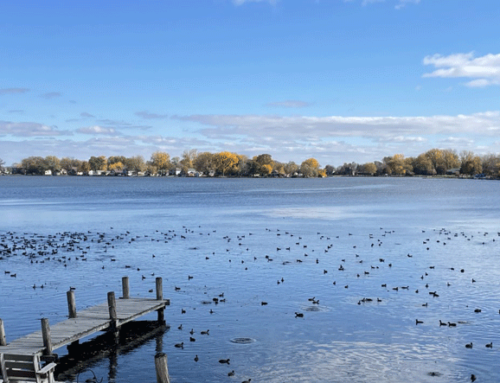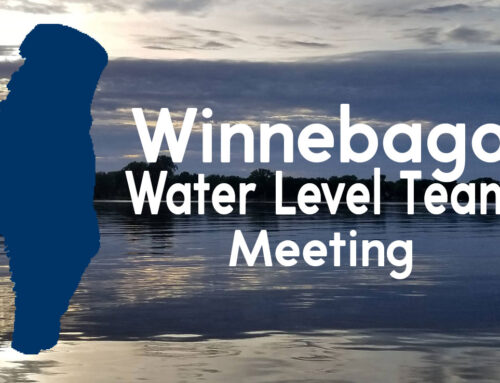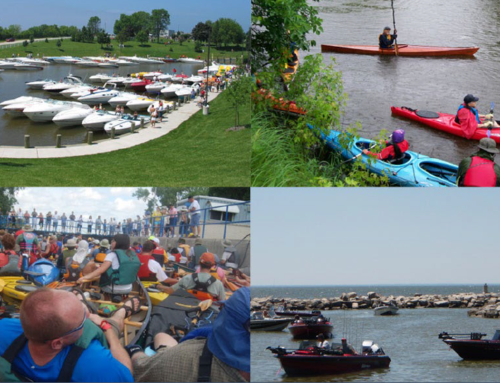What’s the purpose?
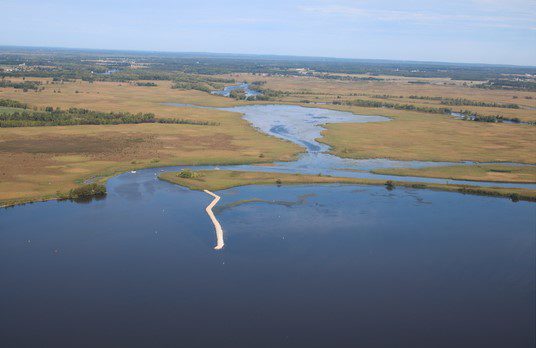
Lake Poygan breakwall at the mouth of the Wolf River. Photo: WDNR
You wouldn’t expect your carrot seedlings to survive if you tilled your garden, right? Soil disturbance obliterates delicate seedlings, and it happens similarly on the lake bed. But, not by tiller, hoe, or innocent toddler. Turbid, high energy water makes it extremely difficult for aquatic plants to establish themselves. The wave energy moving through the water constantly hammers away at the bottom substrate having multiple detrimental effects on plant establishment.
Plants need a relatively stable environment to germinate and get established. However, even if plants are able to get themselves established, growth can be impeded by sediment re-suspension. When the wave energy hits the lake bed and stirs up sediment, the sediment ends up in the water column. All the sediment floating around clouds up the water and reduces sunlight availability for plants.
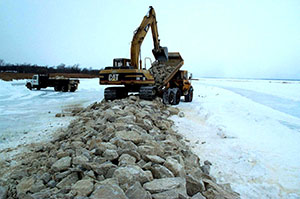
Winter breakwall construction. Photo: Winnebago County LWCD
Now, it comes full circle with the fact that aquatic plants anchor sediment down and make it less susceptible to re-suspension. It’s kind of like your front lawn. A heavy rain will not wash away your front lawn because the roots are holding the soil aggregates together. But if you recently put the grass seed down, or it has just germinated, a heavy rain will leave your yard full of little gullies and all of the seed will be washed down to the street. That being said, existing plants will facilitate further plant establishment. However, the complete absence of plants, paradoxically makes it hard for plants to exist.
The Winnebago System used to support very large and dense populations of aquatic plants. The upper pool lakes were more like vast marshes with very wide river channels running through them, rather than expansive open water bodies. These populations of submergent and emergent plants took up thousands of pounds of nutrients and anchored down the sediment. I would not be surprised if one could see the bottom anywhere in the system. You can read about how suspended solids and phosphorus affect water quality here (phosphorus) and here (sediment).
The two dams at Neenah and Menasha were installed in the mid 1850s, and raised the water level up to three feet in places, dramatically changing the system’s aquatic vegetation. Plants that found their niche in a foot of water were now inundated and did not persist. We might expect that different species would occupy this new niche. This probably would be the case if the system wasn’t so impacted by turbid waters.

Restored habitat behind breakwall on Lake Winnebago. Photo: Winnebago County LWCD
One of the main objectives of a breakwall is to absorb wave energy and quiet the water behind it, thereby encouraging plant establishment. They also work to better water quality by preventing shoreline erosion. The energy of the water hitting the shoreline is greatly reduced by the breakwall, and keeps the shoreline intact. An eroding shoreline contributes to sediment and phosphorus pollution in similar ways that agricultural and storm water run-off does. Not only that, breakwalls create excellent spawning, nesting, rearing, and refuge for wildlife by preserving shoreline habitat and making new high quality habitat when plants start to establish.
Some of the early breakwall attempts in the upper pool lakes consisted of old cars piled up in lines to protect backwaters from wave energy. Most of the cars have been removed, but you can still find some of them embedded in vegetation. Breakwall project planning has come a long way and computers can now model how varying wind energies will move water and interact with the breakwall. Planners need to ensure that the breakwall is effective at reducing the negative impacts of wave energy, but also does not impede water circulation or divert the wave energy elsewhere.
The Winnebago County Land and Water Conservation Department has been installing off-shore breakwaters since 1998 to reestablish aquatic plants and wetlands. The county is currently working on a the second phase of a long arcing break wall near the mouth of the Wolf River. Project partners include Duck’s Unlimited, Lake Poygan Sportsman’s Club, and trustees for the Fox River Natural Resource Damage Assessment (NRDA funds). Phase I of the project consisted of 1,170 feet of limestone break wall being placed in the summer of 2016. Phase II will build onto Phase I and is expected to start Spring of 2019.

Breakwall construction Photo: Winnebago County LWCD
Improving water quality from an in-lake standpoint is a major component of the Lake Management Plan. If all sediment and phosphorus pollution coming into the Winnebago System was magically stopped, there would still be a tremendous amount of phosphorus entering the water as the phosphorus laden lake bed continues to be disturbed. The amount of existing vegetation would be insufficient to sequester the phosphorus and other excess nutrients. Increasing the number of projects that bolster aquatic plant growth will benefit water quality by reducing shoreline erosion, preventing sediment resuspension, and providing an avenue for nutrient uptake/use. Additionally, the system would see economic benefits as prime fishing and hunting habitat would be created. The LMP will work with project partners to recommend, develop and install effective breakwater projects during the implementation phase of the planning project.
Winnebago Waterways is a Fox-Wolf Watershed Alliance program. The Fox-Wolf Watershed Alliance is an independent nonprofit organization that identifies and advocates effective policies and actions that protect, restore, and sustain water resources in the Fox-Wolf River Basin.
Follow the Fox Wolf Watershed Alliance’s Winnebago Waterways Program on our Winnebago Waterways Facebook page or @WinnWaterways on Twitter! You can also sign-up for email updates at WinnebagoWaterways.org.
This post was written by Austin Pethan for the Winnebago Waterways Program. Questions or comments? Contact Austin at austin@fwwa.org or (920) 920-851-4295.


